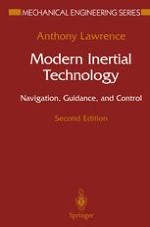1998 | OriginalPaper | Buchkapitel
Two-Degree-of-Freedom Gyroscopes
verfasst von : Anthony Lawrence
Erschienen in: Modern Inertial Technology
Verlag: Springer New York
Enthalten in: Professional Book Archive
Aktivieren Sie unsere intelligente Suche, um passende Fachinhalte oder Patente zu finden.
Wählen Sie Textabschnitte aus um mit Künstlicher Intelligenz passenden Patente zu finden. powered by
Markieren Sie Textabschnitte, um KI-gestützt weitere passende Inhalte zu finden. powered by
In the 1950s, when inertial navigation began, there were two schools of thought as to how to make gyros. To generalize somewhat, the East Coast school, led by Draper (at MIT), opted for single-degree-of-freedom floated gyros, which constrain the precession of a gyro wheel to a single rotational axis (the output axis). The West Coast school, however, successfully made two-degree-of-freedom gyros (2DFGs). Some companies (Litton, and East Coast Arma) made floated 2DFGs, while Autonetics made gimbal-less gyros using a ball-and-socket made from a spherical self-acting gas bearing inside the wheel. Others (Autonetics and neither coast Honeywell) made the ball-and-socket the entire gyro, supporting a sphere either electrostatically or magnetically, the latter type using superconducting materials to eliminate power dissipation and heating. Two-degree-of-freedom gyros are sometimes called two axis-gyros, or free gyros.
